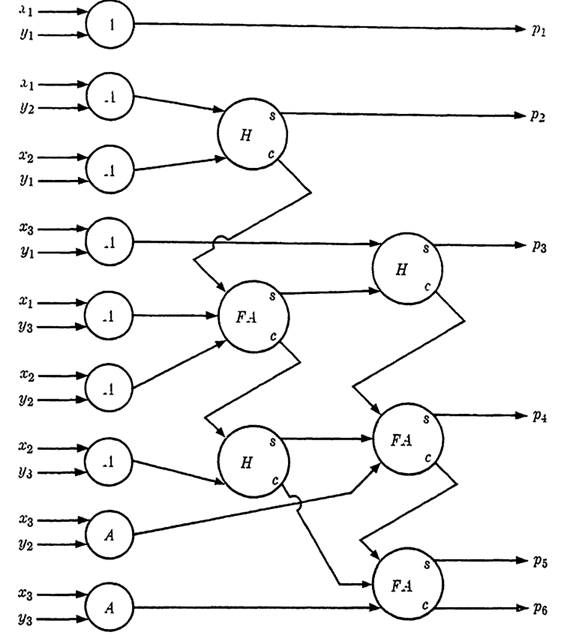
CIRCUITS FOR ARITHMETIC COMPUTATION -Binary multiplication
 المؤلف:
J. ELDON WHITESITT
المؤلف:
J. ELDON WHITESITT
 المصدر:
BOOLEAN ALGEBRA AND ITS APPLICATIONS
المصدر:
BOOLEAN ALGEBRA AND ITS APPLICATIONS
 الجزء والصفحة:
150-153
الجزء والصفحة:
150-153
 29-12-2016
29-12-2016
 1467
1467
It has been mentioned in the other sections on arithmetic operations that many other logical circuits are known and used for each of the operations discussed. This situation is even more pronounced with respect to multiplication. Since the process itself is more complicated, it is only reasonable that more variations exist for multiplication. Among the many methods, the most frequently used are those which employ the use of an accumulator in one way or another. The following binary multiplication problem illustrates the steps which must be performed by the computer:

The partial products are easy to obtain since they are each either zero or identical to the multiplicand. However, the addition is complicated because the partial products to be accumulated are not simply 3-digit numbers since each successive partial product is shifted one position to the left of the partial product above it. Besides accumulation, then, it is necessary to include a shifting device capable of reproducing the multiplicand in any desired position. The shifting may be done either upon the partial products or upon the number in the accumulator itself, just as long as the digits are aligned properly before each step in the computation.

FIG. 1-1. Logical circuit for the simultaneous multiplication of two 3-digit numbers.
The preceding discussion has indicated a way in which the problem of multiplication can be, and usually is, approached. However, rather than introduce the shifting circuits necessary for this approach, we will conclude this chapter with a circuit capable of multiplying two 3-digit numbers directly. This circuit (Fig. 1-1) depends only on logical elements already introduced. Although the circuit is by no means trivially self-evident, a careful consideration of the various paths in connection with the sample problem above should convince the student of the validity of the circuit. The half adder is used with the notation introduced earlier and, in addition, adder, is used with identical notation except that FA replaces the letter H found in a half adder. The two elements perform in the same way except that a full adder accepts three inputs instead of two. The notation for this circuit is similar to that of the adder circuit given earlier in that the multiplicand and multiplier are X = x3x2x1 and
Y = y3, y2,y1 respectively. The product is denoted by P = P6P5P4P3P2P1. Note that it is possible for the product to have six, but not more than six, digits.
A complete discussion of circuits involved in arithmetic operations would fill a book larger than this one. It is not our purpose to exhaust the subject but merely to pursue it to the point that the student may appreciate the nature of such problems and the role that Boolean algebra can be expected to play in their solution. While it is true that we are, at this point, very far from the complete design of a computer, the principles and methods which have been presented should have prepared the reader to solve many interesting and worthwhile problems with the use of electrical circuits of one type or another.
 الاكثر قراءة في الجبر البولياني
الاكثر قراءة في الجبر البولياني
 اخر الاخبار
اخر الاخبار
اخبار العتبة العباسية المقدسة


